How to choose a solid fuel boiler: analyze the operating
The question of how to choose a solid fuel boiler will be of interest, first of all, to owners of summer houses and private country houses. And indeed, where there is not enough cheap gas, and electricity is not always supplied, it is important to have a reliable source of heat, especially in winter.
And though by themselves solid fuel boilers are not complicated, you need to choose them quite meticulously. That is why experts recommend before buying to study your favorite model for a variety of parameters.

Review of materials
Iron products
The choice of a solid fuel boiler usually begins with an analysis of the material from which its body is made. And here we have only two options: either cast iron or steel.
Cast iron boilers are produced by injection molding technique. High-quality cast iron with anti-corrosion additives (manganese, phosphorus, silicon, etc.) is used as a raw material. Most cast-iron models have a sectional design: the heat exchanger consists of individual parts on a threaded joint, and if one section fails, it can be replaced.
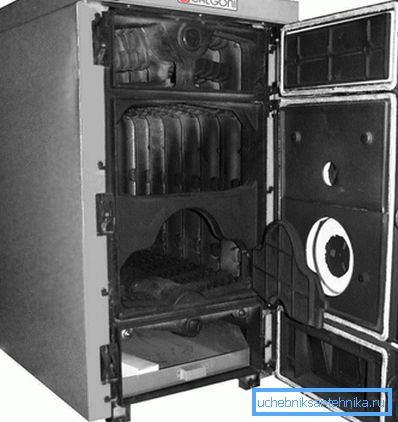
Note! For the sake of justice, it is worth noting that this possibility is rather theoretical: cameras burn through one by one quite rarely, so usually replacing an entire device is usually a much better solution. Yes, and finding a suitable replacement section is also a non-trivial task.
The advantages of cast iron boilers include:
- High strength and durability (instructions for the highest quality models indicate a warranty period of at least 10 - 15 years), which is provided by the properties of the material itself.
- High corrosion resistance (including low temperature and electrochemical corrosion).
- Easy maintenance.
- Possibility of repair, as well as increasing the capacity of the installation by adding sections of their own hands.
To make the use of the boiler as safe as possible, it is worth remembering the drawbacks of cast iron models:
- First, the metal does not tolerate temperature drops, which can lead to cracks in the heat exchanger. That is why the construction of most models provides a mixer, which prevents the ingress of cold water on hot surfaces.
- Secondly, it is undesirable to subject the walls of the boiler to shock loads.
- Finally, the thermal efficiency of such installations is lower than that of steel ones.
Steel Products
For the manufacture of steel models used plates of heat-resistant steel, which are welded. As a rule, manufacturers of high-quality devices use metal with a thickness of at least 4 mm, which provides the optimal combination of good thermal conductivity with a safety margin of the material.

Unlike cast iron, steel heat exchangers have an integral structure. On the one hand, this increases their reliability, but on the other hand, it somewhat reduces maintainability and eliminates the possibility of increasing the power of the device.
Another important factor determining the quality of the boiler is the insulation between the casing and the heat exchanger. It is advisable to purchase devices that are equipped with a heat insulator based on basalt cotton wool.
The advantages of steel models are:
- Both the casing and the heat exchanger are characterized by high impact resistance.: in this parameter steel is many times greater than cast iron.
- Relatively small mass facilitates transportation and installation.
- If damage is detected, the heat exchanger can be repaired using welding..
- The use of steel plates with good thermal conductivity provides high heat transfer.

If it speaks of minuses, they are mainly associated with the risk of corrosion: when in contact with hot water, the steel is oxidized, so that the heat exchanger needs to be periodically cleaned of layers. Otherwise, the power of the device will be significantly reduced, in addition, the risk of damage to parts due to insufficiently effective heat dissipation will increase.
Functional parameters
Burning or pyrolysis?
Speaking about what kind of solid fuel boiler to choose, you need to pay attention to the principles on which the installation operates. On the market you can find both classic models and models working on the pyrolysis mechanism:

| Device type | Features of work |
| Burning boilers |
|
| Pyrolysis boilers |
|
It is quite difficult to choose between the classical model and the pyrolysis device.
On the one hand, high-tech devices have several advantages:
- First, they have great efficiency.
- Secondly, the presence of a fan that provides the movement of gas inside the circuit reduces the requirements for the efficiency of the chimney.
- Finally, using a gas generator heating unit, we can regulate the power of the heating system over a wider range.
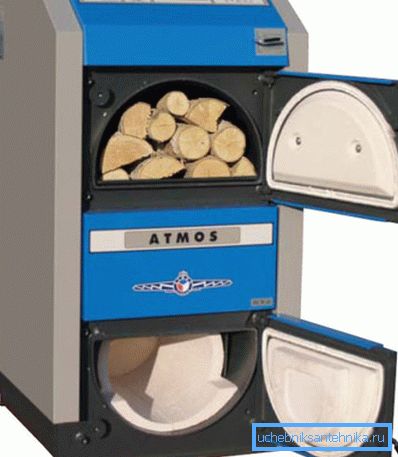
However, in a number of parameters, pyrolysis boilers are inferior to classic ones:
- They are characterized by a higher price (the excess at the equivalent power and class can be up to 70 -80%).
- The requirements for the moisture of the material being burned are also quite strict: the wood must be dried for at least one year, while avoiding precipitation.
That is why, despite the advantages of pyrolysis technology, many people choose conventional devices for the direct combustion of combustible material.
Fuel used
The next question to be answered when deciding which solid fuel boiler to choose concerns the type of fuel used:
- The vast majority of models on the market are universal. This means that they can use almost any combustible material, be it coal, firewood or pellets for heating.
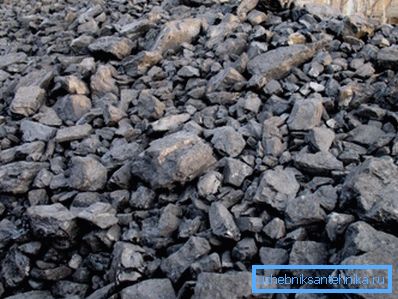
- However, manufacturers of heaters usually design them all the same for a particular fuel, and it is desirable to use it. Otherwise, there will be a significant drop in device performance.
The most common types of fuel include:
- Coal - brown or anthracite. The material has a high energy intensity, and therefore takes up less volume than other types of fuel. On the other hand, in some regions only imported coal is used, therefore its cost will be quite high.
- Firewood is a universal option, available almost everywhere (except, of course, the territories completely devoid of woody vegetation). When using firewood as fuel, special attention should be paid to their humidity - the drier the wood, the better it will burn. To protect the wood from moisture, they usually either use special rooms or erect shelters that protect from rain and snow.
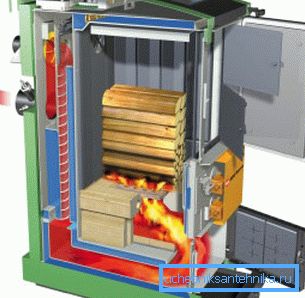
Tip! Even if the wood was stored in a covered woodpile, they dampen the air. So before use, it is better to bring them to the house or shed for drying for several days.
- Pellets are small products made of pressed wood raw materials (chips, sawdust, chips) with various additives that improve combustion. They have sufficient energy consumption, in addition, can be used in automatic fuel supply systems, which greatly facilitates the maintenance of the boiler.
- The intermediate position between the pellets and firewood is occupied by the so-called fuel briquettes - quite large products from pressed chips and chips with special impregnations. They are used in the same way as ordinary logs, but they emit much more heat when burned.
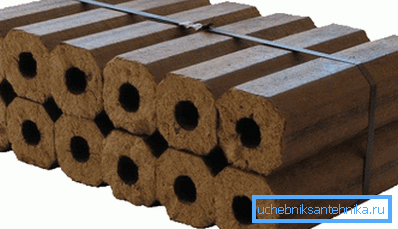
In any case, choosing the main type of fuel, you need to focus on the conditions in your region: what is available in the right quantity and at an affordable price will be the best option!
Device power
The next parameter is the heat output of the heating installation. Before you choose solid fuel boilers, you need to calculate the needs of your building in thermal energy so as not to overpay, but not to freeze.
The calculations themselves are quite simple:
- For every 10 m2 House space needs a minimum of 1 kW of heater power. Accordingly, compact models with a capacity of up to 10 kWh will be suitable for country houses, and most private households can be successfully heated with installations of 20–25 kWh.
- If you are using outdoor insulation systems of mineral wool, polymers or foam concrete, then the heat loss at home will be significantly reduced. So in this situation, you can proceed from the ratio of 12 - 15 m2 / 1 kWh
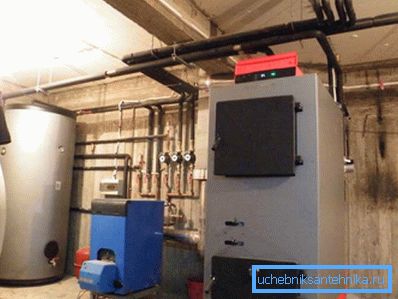
Note! This calculation is suitable for the middle zone of the Russian Federation, where the minimum winter temperature rarely falls below -30. 0C. For areas with more severe winters, it is better to make a margin of at least 30-40% capacity.
Features of work
As a matter of fact, we analyzed the main parameters in the previous sections, only some details remained. However, they are worth paying attention to, since insignificant nuances at first glance largely determine the comfort of using the installation.
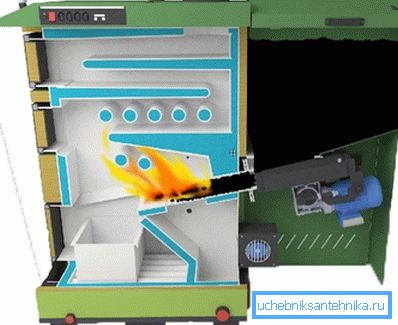
First of all, it is necessary to determine the type of fuel supply:
- Manual loading is the easiest, but in this case we will have to put new portions of fuel into the furnace every few hours. If the boiler is located in the house - it is not so bad, but from time to time it will be difficult to descend into the basement.
- To avoid this, you can purchase an automatic fuel supply system to the combustion chamber. As a rule, most modern models are equipped with such systems: the rise in price will be relatively small, but one hopper load will be enough for several days of work.
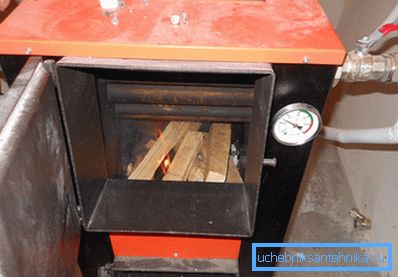
Note! The systems of automatic feeding of pellets and crushed coal work best, although a suitable model can be found for firewood.
- The next point is volatility. Devices that require electrical connection are usually equipped with a control panel and a fan forcing oxygen into the furnace. They provide more complete combustion of fuel, increasing heating efficiency.
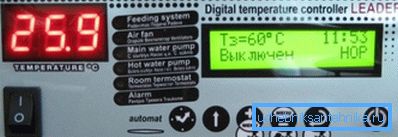
- Non-volatile models are simpler in design and function due to the natural circulation of hot air. On the other hand, they are not afraid of a power outage, so you can be sure that you will not freeze in any situation.
Conclusion
Of course, all the recommendations on how to choose heating boilers for solid fuels should be studied in accordance with your conditions. Not all the described advantages of these or other systems will be relevant for you, therefore there can be no universal solution.
But if you understand the basic principles of choice and carefully review the video presented, then with a guarantee you will find a heating unit that is ideal for your home.